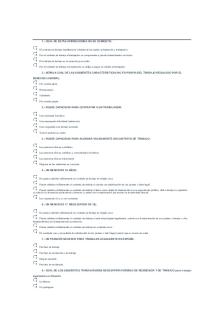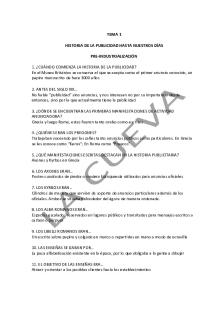Kahoot 7 Boxplot (preguntas tipo test) PDF

| Title | Kahoot 7 Boxplot (preguntas tipo test) |
|---|---|
| Course | Tècniques De Recerca |
| Institution | Universitat de Barcelona |
| Pages | 3 |
| File Size | 80.9 KB |
| File Type | |
| Total Views | 143 |
Summary
preguntas tipo test tema 7
Kahoot 7 Boxplot...
Description
Questions related to the video How to make a box and whisker plot
1. The first step in creating a boxplot is a) Identifying the median: For identifying the median, the data should be sorted from smallest to largest b) Identifying the minimum and maximum values: For identifying the minimum and maximum, the data should be sorted from smallest to largest c) Sorting the data in ascending order: always when using indices based on position (quartiles, midhinge, interquartile range, certain shape indices) d) Drawing the box: The box is determined by quartiles 1 and 3, which are identified after the data are sorted from smallest to largest
2. The percentage of values represented by the box is a) 0%: does not make sense to represent 0% of the data b) 25%: between each extreme of the box (quartiles 1 and 3) and the median (quartile 2) c) 50%: the box is determined by quartile 1 (marking the lowest 25% of the data) and quartile 3 (marking the lowest 75% of the data): thus, the box includes 50% of the data d) 75%: that’s the amount of the data between minimum (lower extreme of the lower whisker) and quartile 3 (upper extreme of the box), or between quartile 1 (lower extreme of the box) and maximum (upper extreme of the upper whisker)
3. In absence of outliers, each of the two whiskers represents a) 0% of the values: does not make sense to represent 0% of the data b) 25% of the values: the box represents the central 50% and each whisker represents half of the remaining data – the lowest 25% and the highest 25% c) 50% of the values: this would be the two whiskers together d) 75% of the values: it is impossible, because that would add up to more than 100% of the data
4. When there is a large outlying value, the maximum value is a) The outlier: Calling it outlier does not make it disappear or not count. b) The value represented by the extreme of the upper whisker: This is the upper adjacent value: the largest value that is not an outlier (In the current example, the second largest value overall, after the outlier). c) The value represented by the upper extreme of the box: This is quartile 3: both the outlier and the upper adjacent value are larger. d) The value corresponding to quartile 4: Quartile 4 does not exist: there are 3 quartiles, dividing the sorted series of data into four quarters. 5. When there is a large outlying value, the extreme of the upper whisker is called a) Outlier: The outlier is a dot or an asterisk outside of the whisker b) Maximum: The maximum value is the outlier c) Upper adjacent value : This is the largest value that is within the upper fence defined by quartile 3 + 1.5 times the interquartile range d) Quartile 3: That’s the upper extreme of the box, not of the whisker
6. A measure of dispersion (scatter) used for identifying outliers is a) The range: Not logical, because the range is defined on the basis of the minimum and maximum value (some of which is potentially an outlier) b) The interquartile range: Atypical values are more than 1.5 times the interquartile range below quartile 1 or above quartile 3. Extreme outlying values are more than 3 times the interquartile range below quartile 1 or above quartile 3. c) The variance: the variance is based on moments, unlike the boxplot which uses indices based on position. d) The average of the quartiles: The midhinge is a measure of central tendency, not a measure of scatter.
7. How many quartiles are represented in the boxplot? a) 1: This would not be sufficient for representing variability b) 2: The box is defined by two quartiles (Q1 and Q3), but it also contains the Q2 within, as a thicker line c) 3: All three quartiles are represented. d) 4: Only three quartiles exist, dividing the ordered set of measurements into four quarters
8. How is the interquartile range represented in the boxplot? a) It is the distance between the minimum and maximum values: That’s the range b) It is the distance between the Q1 and Q2: That’s only part of the interquartile range c) It is the spread of the whiskers: Each whisker represents the variability in the lowest and highest 25% of the data d) It is the size of the box : The interquartile range represents the variability of the central 50% of the data, which is represented by the box.
9. A larger box represents a) Greater variability: The larger the box, in the vertical direction, the greater the heterogeneity of the central 50% of the data (i.e., greater interquartile range). b) More values: The size of the box (or of the whiskers) does not represent the amount of data; it represents the amount of scatter. c) Smaller median: a smaller median would be represented by a thick line represented relatively low. d) Lack of symmetry: symmetry can be assessed comparing the extremes of the whiskers to the median (skewness of 100% of the data) or comparing the extremes of the box to the median (skewness of the central 50% of the data).
10. How many useful dimensions has the boxplot as a graphical representation? a) 0: If there were no dimensions (vertical, horizontal, depth, time/movement), there would be nothing to represent or see in the plot b) 1: In the usual vertical representation of the boxplot, only the vertical dimension is useful (representing scatter), whereas the horizontal dimension (e.g., the width of the box) does not mean anything. Only one variable is represented. c) 2: a scatterplot is bidimensional for representing two variables at the same time d) 3: 3D scatter plots exist for representing three variables at the same time...
Similar Free PDFs

Tipo test, preguntas
- 48 Pages

Preguntas tipo test creatividad
- 4 Pages

Preguntas tipo test
- 17 Pages

Preguntas TIPO TEST Infancia
- 14 Pages

Preguntas TIPO TEST DUE
- 22 Pages

Preguntas TIPO TEST Resueltas
- 6 Pages

Preguntas TIPO TEST HS5
- 35 Pages

Preguntas tipo test
- 3 Pages

TIPO TEST, preguntas
- 10 Pages

preguntas tipo test
- 28 Pages

Preguntas tipo test
- 3 Pages

Tipo test 2021, preguntas
- 7 Pages

Preguntas tipo test
- 3 Pages

Preguntas TIPO TEST S8
- 9 Pages
Popular Institutions
- Tinajero National High School - Annex
- Politeknik Caltex Riau
- Yokohama City University
- SGT University
- University of Al-Qadisiyah
- Divine Word College of Vigan
- Techniek College Rotterdam
- Universidade de Santiago
- Universiti Teknologi MARA Cawangan Johor Kampus Pasir Gudang
- Poltekkes Kemenkes Yogyakarta
- Baguio City National High School
- Colegio san marcos
- preparatoria uno
- Centro de Bachillerato Tecnológico Industrial y de Servicios No. 107
- Dalian Maritime University
- Quang Trung Secondary School
- Colegio Tecnológico en Informática
- Corporación Regional de Educación Superior
- Grupo CEDVA
- Dar Al Uloom University
- Centro de Estudios Preuniversitarios de la Universidad Nacional de Ingeniería
- 上智大学
- Aakash International School, Nuna Majara
- San Felipe Neri Catholic School
- Kang Chiao International School - New Taipei City
- Misamis Occidental National High School
- Institución Educativa Escuela Normal Juan Ladrilleros
- Kolehiyo ng Pantukan
- Batanes State College
- Instituto Continental
- Sekolah Menengah Kejuruan Kesehatan Kaltara (Tarakan)
- Colegio de La Inmaculada Concepcion - Cebu

